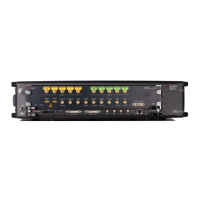4 Digital Up-Conversion
132 M8190A User’s Guide
The drawing above illustrates the mechanisms of how the configuration of the
instrument can be changed at run-time. The right side shows the sequence table and
the waveform memory (see Sequencing). The left side shows tables containing
configuration data provided by the user.
The following tables are available:
Amplitude Table: stores multiplication factors for the amplitude multiplier (see
Figure 4-1). For more details how to program an amplitude table, see
:ATABle Subsystem.
Frequency Table: stores frequency values for the NCO. For more details how to
program a frequency table, see :FTABle Subsystem.
Action Table: stores sets of complex commands. For more details how to program
an action table, see :ACTion Subsystem.
The access to these tables is controlled by the sequencer of the instrument. For more
details how to access the tables, see :STABle Subsystem.
4.3.1 Configuration using Standard Data Segments
The access to the amplitude and frequency table is possible via standard data
segments.
Every standard segment can be armed with 4 flags (see :STABle Subsystem):
Initialize Amplitude Table Address
Initializes the address pointer of the amplitude table to zero and causes the amplitude table value of
index zero to be transferred to the DAC. The new amplitude multiplication factor becomes active
immediately.
Increment Amplitude Table Address
Increments the address pointer of the amplitude table by one and causes the amplitude table value
of the new index to be transferred to the DAC. The new amplitude multiplication factor becomes
active immediately.
Initialize Frequency Table Address
Initializes the address pointer of the frequency table to zero and causes the frequency table value of
index zero to be transferred to the DAC. The new NCO frequency value becomes active immediately.
Increment Frequency Table Address
Increments the address pointer of the frequency table by one and causes the frequency table value
of the new index to be transferred to the DAC. The new NCO frequency value becomes active
immediately.
Frequency and amplitude table are altogether independent. Therefore, it is allowed to
change the amplitude multiplication factor and the NCO frequency together.
Initializing and incrementing a table offset at the same time does not make any sense
and is therefore not allowed.
Each table has a storage capability of 32k entries.
When looping over a segment multiple times, increment and initialization flags are only
evaluated once at the beginning of the first loop.
Frequency and amplitude changes are not aligned to the corresponding segment
boundaries. The following table shows a rough timing relationship between the
beginning of a segment containing increment or init flags and the corresponding
change of the frequency or amplitude.

